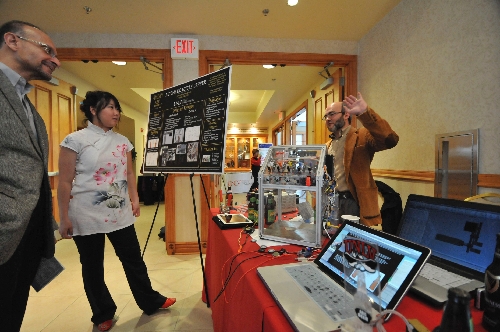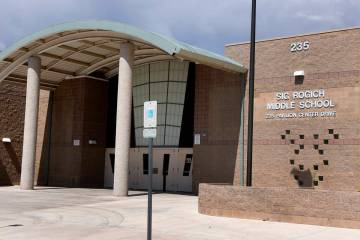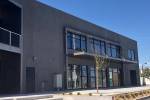UNLV student design projects seek to solve practical problems
More than 30 teams of undergraduate engineering students showed off their ingenuity Dec. 5 at the University of Nevada, Las Vegas during the 2012 Senior Design Competition.
Students made interactive video games, an automatic bottle capper for home brewers, a motorized TV wall mount and more.
A few teams' projects could benefit UNLV. One such project is a parking garage that will be built at the southern end of campus at 4505 S. Maryland Parkway near In-N-Out Burger as part of UNLV's Campus Master Plan.
The students approached the university's planning and construction department and asked if there were projects they could help with.
"So they asked us to make a parking garage," Josh Palmer said. "They may not use the entire thing, but they'll probably use some of our ideas."
The students' proposed garage would have between 1,000 and 1,500 spaces in a seven-story structure. But unlike most garages, the first floor would be entirely for commercial space.
"The elevators open up to an atrium in the first floor so you have a more on-campus lifestyle that (UNLV) is trying to support, while also allowing additional parking," Steven Ireland said.
The team also borrowed an idea from the new parking garage at Santa Fe Station, 4949 N. Rancho Drive, which has a ramp on the outside of the garage, allowing for less congestion and faster entry and exit times. The proposed UNLV structure would have two outside ramps and space for a Regional Transportation Commission of Southern Nevada bus depot.
The competition was the 12th annual event for the Howard R. Hughes College of Engineering. Every senior engineering student is required to participate. Many past student teams have developed their products into businesses.
Daniel Sigler said he probably could make money off his project, but he plans to upload instructions on how to build it to the team's website, autobeercapper.com.
Sigler's team created the Automatic Bottle Capper. Sigler started home brewing beer in 2009 after a former UNLV engineering professor and experienced brewer moved away and gave most of his equipment to Sigler and others.
In the past they used a traditional hand capper to squeeze bottle caps on recycled bottles. The problem, Sigler said, is that the hand capper usually broke between two and five bottles per batch.
"We were the client for this project," Sigler said. "You spend anywhere from three to six weeks brewing the beer, and you're bottling it and you break it ---- sad face."
The automated machine self-centers the bottle and caps it in about 20 seconds, which is about the amount of time it takes to fill the next bottle, Sigler said.
Sigler and his team added one other option to their machine that makes it unique. It has the ability to post updates to Twitter while bottling beer.
"The more bottles it caps in a given batch, the drunker the tweets get," Sigler said. "The tweets start out fairly sober, but by the time you get toward the end, it starts getting a little more personality and a little more fun."
Some tweets include, "Bottle 4 is done," "Bottle 12 I've capped you!" and "Bottle 16 what was I saying?"
Another student project that could potentially help UNLV is a gray water reclamation system for student housing. The design would collect water from showers, sinks and laundry machines in the dorms, run it through a treatment facility and recycle it for toilet use or irrigation.
"Water is a big issue here," Joseph Marsella said. "We thought a water-recycling project might be a good idea."
Marsella said it is not economically feasible for the university ---- it would cost about $280,000 to install, the team estimated ---- but that it could become cheaper as such systems become more popular.
He said these kinds of systems are being used in Arizona and that one resident hall using the irrigation component could save an estimated 3.8 million gallons of water annually.
Another team created an automated sock assist machine after getting the idea from a UNLV doctor who told them about a friend who is unable to put on his own socks.
"Quite a few people have this problem probably," said Caleb Maher, citing people with back injuries or arthritis or obese people as the market for their product.
Another group designed a house for the U.S. Department of Energy's 2013 Solar Decathlon. UNLV is one of 20 universities around the world competing to design and build a fully functional house that is energy efficient, affordable and attractive.
Construction of the house is to begin in January, and the competition is scheduled for October 2013 in Irvine, Calif. Students will have to move the house to California for the competition and host a dinner party for the judges inside it.
"We feel really confident," Russell McLellan said. "(The house is) kind of rare because we have an aggressive design. Some of the past winners were just boxes."
The house will be made of timber and feature multiple systems that save and generate energy, making it a net-zero energy home that could generate a surplus to be put back into a city's power grid.
Team member Iani Batilov said the house will also feature thermal flooring, which heats and cools the house through a network of tubing under the floor running hot and cold water.
"That's how you control the climate in the room," Batilov said. "You get better comfort and better performance."
The house is also being worked on by other UNLV students in areas of electrical, mechanical, plumbing, construction management, architecture, marketing, business and more.
For more information, visit engineering.unlv.edu.
Contact View education reporter Jeff Mosier at jmosier@viewnews.com or 702-224-5524.




























